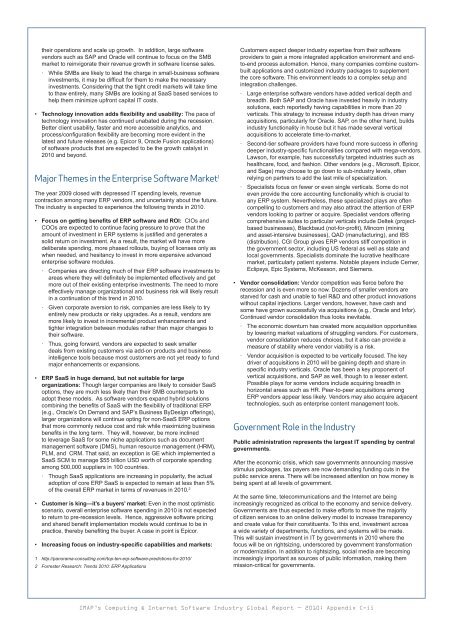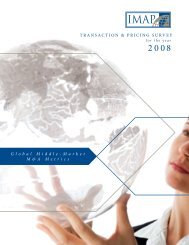Computing & internet software global report 2010.pdf - IMAP
Computing & internet software global report 2010.pdf - IMAP
Computing & internet software global report 2010.pdf - IMAP
- No tags were found...
You also want an ePaper? Increase the reach of your titles
YUMPU automatically turns print PDFs into web optimized ePapers that Google loves.
their operations and scale up growth. In addition, large <strong>software</strong>vendors such as SAP and Oracle will continue to focus on the SMBmarket to reinvigorate their revenue growth in <strong>software</strong> license sales.· While SMBs are likely to lead the charge in small-business <strong>software</strong>investments, it may be difficult for them to make the necessaryinvestments. Considering that the tight credit markets will take timeto thaw entirely, many SMBs are looking at SaaS based services tohelp them minimize upfront capital IT costs.• Technology innovation adds flexibility and usability: The pace oftechnology innovation has continued unabated during the recession.Better client usability, faster and more accessible analytics, andprocess/configuration flexibility are becoming more evident in thelatest and future releases (e.g. Epicor 9, Oracle Fusion applications)of <strong>software</strong> products that are expected to be the growth catalyst in2010 and beyond.Major Themes in the Enterprise Software Market 1The year 2009 closed with depressed IT spending levels, revenuecontraction among many ERP vendors, and uncertainty about the future.The industry is expected to experience the following trends in 2010.• Focus on getting benefits of ERP <strong>software</strong> and ROI: CIOs andCOOs are expected to continue facing pressure to prove that theamount of investment in ERP systems is justified and generates asolid return on investment. As a result, the market will have moredeliberate spending, more phased rollouts, buying of licenses only aswhen needed, and hesitancy to invest in more expensive advancedenterprise <strong>software</strong> modules.· Companies are directing much of their ERP <strong>software</strong> investments toareas where they will definitely be implemented effectively and getmore out of their existing enterprise investments. The need to moreeffectively manage organizational and business risk will likely resultin a continuation of this trend in 2010.· Given corporate aversion to risk, companies are less likely to tryentirely new products or risky upgrades. As a result, vendors aremore likely to invest in incremental product enhancements andtighter integration between modules rather than major changes totheir <strong>software</strong>.· Thus, going forward, vendors are expected to seek smallerdeals from existing customers via add-on products and businessintelligence tools because most customers are not yet ready to fundmajor enhancements or expansions.• ERP SaaS in huge demand, but not suitable for largeorganizations: Though larger companies are likely to consider SaaSoptions, they are much less likely than their SMB counterparts toadopt these models. As <strong>software</strong> vendors expand hybrid solutionscombining the benefits of SaaS with the flexibility of traditional ERP(e.g., Oracle’s On Demand and SAP’s Business ByDesign offerings),larger organizations will continue opting for non-SaaS ERP optionsthat more commonly reduce cost and risk while maximizing businessbenefits in the long term. They will, however, be more inclinedto leverage SaaS for some niche applications such as documentmanagement <strong>software</strong> (DMS), human resource management (HRM),PLM, and CRM. That said, an exception is GE which implemented aSaaS SCM to manage $55 billion USD worth of corporate spendingamong 500,000 suppliers in 100 countries.· Though SaaS applications are increasing in popularity, the actualadoption of core ERP SaaS is expected to remain at less than 5%of the overall ERP market in terms of revenues in 2010. 2• Customer is king—it’s a buyers’ market: Even in the most optimisticscenario, overall enterprise <strong>software</strong> spending in 2010 is not expectedto return to pre-recession levels. Hence, aggressive <strong>software</strong> pricingand shared benefit implementation models would continue to be inpractice, thereby benefiting the buyer. A case in point is Epicor.• Increasing focus on industry-specific capabilities and markets:1 http://panorama-consulting.com/top-ten-erp-<strong>software</strong>-predictions-for-2010/2 Forrester Research: Trends 2010: ERP ApplicationsCustomers expect deeper industry expertise from their <strong>software</strong>providers to gain a more integrated application environment and endto-endprocess automation. Hence, many companies combine custombuiltapplications and customized industry packages to supplementthe core <strong>software</strong>. This environment leads to a complex setup andintegration challenges.· Large enterprise <strong>software</strong> vendors have added vertical depth andbreadth. Both SAP and Oracle have invested heavily in industrysolutions, each <strong>report</strong>edly having capabilities in more than 20verticals. This strategy to increase industry depth has driven manyacquisitions, particularly for Oracle. SAP, on the other hand, buildsindustry functionality in house but it has made several verticalacquisitions to accelerate time-to-market.· Second-tier <strong>software</strong> providers have found more success in offeringdeeper industry-specific functionalities compared with mega-vendors.Lawson, for example, has successfully targeted industries such ashealthcare, food, and fashion. Other vendors (e.g., Microsoft, Epicor,and Sage) may choose to go down to sub-industry levels, oftenrelying on partners to add the last mile of specialization.· Specialists focus on fewer or even single verticals. Some do noteven provide the core accounting functionality which is crucial toany ERP system. Nevertheless, these specialized plays are oftencompelling to customers and may also attract the attention of ERPvendors looking to partner or acquire. Specialist vendors offeringcomprehensive suites to particular verticals include Deltek (projectbasedbusinesses), Blackbaud (not-for-profit), Mincom (miningand asset-intensive businesses), QAD (manufacturing), and IBS(distribution). CGI Group gives ERP vendors stiff competition inthe government sector, including US federal as well as state andlocal governments. Specialists dominate the lucrative healthcaremarket, particularly patient systems. Notable players include Cerner,Eclipsys, Epic Systems, McKesson, and Siemens.• Vendor consolidation: Vendor competition was fierce before therecession and is even more so now. Dozens of smaller vendors arestarved for cash and unable to fuel R&D and other product innovationswithout capital injections. Larger vendors, however, have cash andsome have grown successfully via acquisitions (e.g., Oracle and Infor).Continued vendor consolidation thus looks inevitable.· The economic downturn has created more acquisition opportunitiesby lowering market valuations of struggling vendors. For customers,vendor consolidation reduces choices, but it also can provide ameasure of stability where vendor viability is a risk.· Vendor acquisition is expected to be vertically focused. The keydriver of acquisitions in 2010 will be gaining depth and share inspecific industry verticals. Oracle has been a key proponent ofvertical acquisitions, and SAP as well, though to a lesser extent.Possible plays for some vendors include acquiring breadth inhorizontal areas such as HR. Peer-to-peer acquisitions amongERP vendors appear less likely. Vendors may also acquire adjacenttechnologies, such as enterprise content management tools.Government Role in the IndustryPublic administration represents the largest IT spending by centralgovernments.After the economic crisis, which saw governments announcing massivestimulus packages, tax payers are now demanding funding cuts in thepublic service arena. There will be increased attention on how money isbeing spent at all levels of government.At the same time, telecommunications and the Internet are beingincreasingly recognized as critical to the economy and service delivery.Governments are thus expected to make efforts to move the majorityof citizen services to an online delivery model to increase transparencyand create value for their constituents. To this end, investment acrossa wide variety of departments, functions, and systems will be made.This will sustain investment in IT by governments in 2010 where thefocus will be on rightsizing, underscored by government transformationor modernization. In addition to rightsizing, social media are becomingincreasingly important as sources of public information, making themmission-critical for governments.<strong>IMAP</strong>’s <strong>Computing</strong> & Internet Software Industry Global Report — 2010: Appendix C-ii








